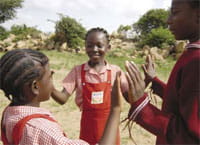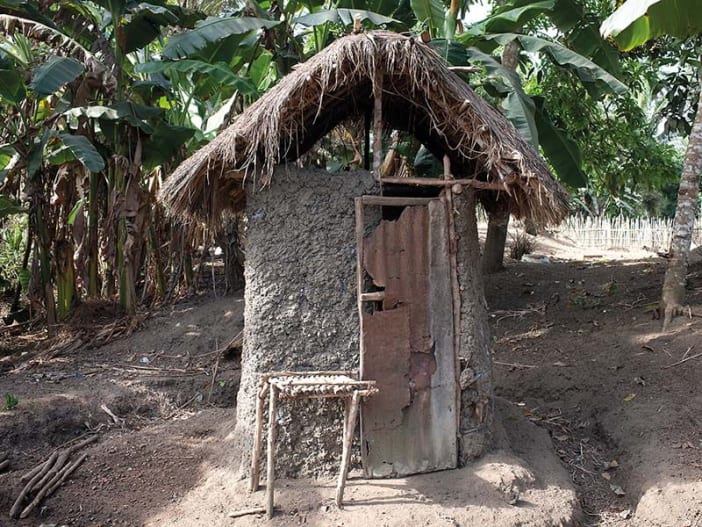- only 40% of schools in Nigeria had water facilities (covered well, covered borehole or tap)
- only 18.7% had adequate latrines and other sanitation facilities
- only 48% of these had separate latrines for girls.
There is a need for continual efforts to keep sanitation on the agenda.
Improving sanitation is not just a question of constructing latrines and facilities. The Health and Sustainable Development Association of Nigeria (HESDAN) has been working in partnership with the Local Government Education Authority and the Ministry of Health on a ‘School Sanitation’ campaign. This campaign was an attempt to inform, persuade and motivate the whole community to improve sanitation and hygiene practices in schools. Through this it aimed to help reduce the dropout rate among girls, improve academic performance and prevent disease related to water and sanitation.
The primary target group was school children, as they are more open to new ideas and are at an age when they can be influenced to develop good habits. School teachers, parents and policy-makers were secondary target groups. The campaign slogan was; ‘school health, sanitation and nutrition: a responsibility for all’.
Our strategy was based on research. A baseline survey was done in 230 schools, to give an indication of the current hygiene practices, awareness of sanitation issues and presence of sanitation facilities in primary schools. We asked questions to find out what motivated people regarding sanitation. The results were used to design the materials and messages for the community campaign. We found that issues related to social status and prestige were important. The majority of the respondents in the survey said they were influenced mostly by what their neighbours thought of them.
Communicating the message
For people to want to be involved, hygiene issues needed to be seen as appealing and a positive thing to do. The communication had to be exciting, non-threatening, socially beneficial and fun. Therefore, we wanted the message to be, ‘sanitation is attractive’. Since we would be communicating to such a diverse audience we needed to create different moods and messages for the different target audiences. Here are some of the messages we used:
For school children
- Being clean is good for you and your classmates.
- Be the envy of your classmates.
For school teachers and school management
- Good hygiene facilities will make your school rank among the best schools. You might win an award and more children will enrol in your school.
For parents
- A responsible parent ensures that their children go to a school of good standard.
- Get respect from your neighbours.
For politicians
- Create a sense of national pride and development by ensuring proper resource allocation, accountability and community participation around sanitation.
Planning a campaign
The project implementation committee met monthly and eventually weekly as the campaign launch date drew near, to plan the campaign. After research and planning, the following activities were carried out:
PRODUCTION OF MATERIALS Posters, leaflets and banners about safe water, nutrition, waste disposal and hand-washing were produced and distributed. We found that these adverts are a good way of alerting people to keep clean and observe good hygiene.
TRAINING WORKSHOPS We held training workshops for teachers and parents. The training covered topics such as health promotion, personal hygiene, preventing diseases, safe water, hand-washing, nutrition and community participation. The teachers and parents then trained pupils to be peer educators within their schools.
LAUNCH ACTIVITIES To publicise the campaign, clubs with activities related to sanitation, health and nutrition were established in schools. Teachers and prefects were put in charge of monitoring sanitation and hygiene. Mini water filters were provided to primary schools.
Gathering feedback
To monitor the impact of the School Sanitation campaign, we commissioned a baseline survey at the start of the campaign and a final evaluation at the end. The evaluation found that over 90% of respondents were aware of the campaign. Feedback was also received informally from peers and community members. The following are some of the immediate responses and comments on the community campaign.
- People talked about the campaign messages with friends, neighbours and relatives.
- Many in the community reported that they had made changes in their own life by improving their latrine hygiene and cleanliness at home.
- School children realised that they should wash their hands after using the toilet and that it is their right to have good sanitation at school. They said they had learned to clean toilets at school and that they encouraged their siblings to respect hygienic conditions.
- Head teachers realised that children have a right to good sanitation and that parents have a right to inspect and monitor health, sanitation and nutrition in schools. One head teacher reported that previously, pupils would often fall asleep in lessons or were frequently absent because of illness. Since being involved in the school health and sanitation programme, these pupils were now participating more actively in classes and sports activities.
- The Local Government Education Authority realised that it is their responsibility to inspect schools within their locality, to ensure they have good sanitation facilities, such as water, soap, water filters and latrines.
Conclusion
The campaign reminded people of their
responsibility to maintain good sanitation
in their communities. It encouraged
community involvement, and greater
accountability between parents, schools
and education authorities. Community
campaigns, though costly, can be effective
for sharing information and for motivating
behaviour change. The cost is surely worth
it for the benefits that come from keeping
sanitation on the agenda. What greater
benefit can you have than ensuring the
health of families within your community?
Awoyemi Olawale is a programme offi cer with the
Health and Sustainable Development Association of
Nigeria (HESDAN).
30A Sabiu Ajose Street, off Bode Thomas
Surulere
Lagos state
Nigeria
Email: [email protected]









